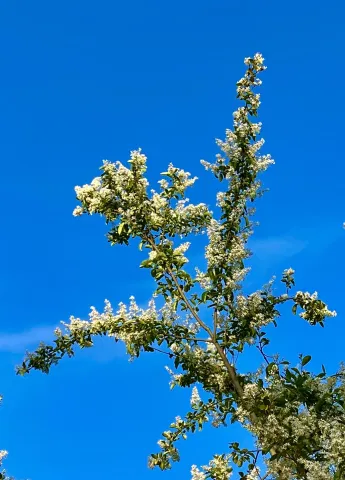Privet: A Pretty Bush You Don’t Want to See or Smell

By Steve Roark
Volunteer, Cumberland Gap National Historical Park.
Right now if you’re outside much you are liable to catch a whiff of an almost overpowering flower smell, and if you investigate, you will likely find a bush loaded with small white flowers. This is Privet, a foreign shrub brought in as a landscape plant as early as the late 1700s. It has unfortunately gone Frankenstein and naturalized into the wild, where it is now very common to see along roadsides, woodland edges, and fencerows. It is bad news and a serious threat to our mountain farms and forests.
Privet (Ligustrum species) is native to China and Japan, and as mentioned was brought over as a landscape plant, particularly used as a hedge around gardens and yards because if can tolerate severe pruning and can be shaped anyway you want to. It is a shrub that forms multiple stems that support a dense canopy of small oval leaves. Each mature shrub can produce upwards of a thousand small white flowers, that in turn produce thousands of small purplish to black berries containing many seeds. The berry is a favored food for several bird species, especially the Thrush, which then fly off and poop out the seeds for miles around, allowing the shrub to rapidly expand its population.
Privet has other advantages that allow it to easily outcompete native plants. They can also reproduce through root suckering, making them difficult to kill. They adapt well to varying light conditions, though they don’t do well in deeply shaded, undisturbed forests. But stir up the soil with a new road or timber harvest that allows more light to get in, and Privet can seed in and rapidly take over the area. They are especially fond of forest edges, where they get plenty of light but are protected from mowing equipment.
Here’s the scary thing. Forests containing large amounts of Privet tend to have fewer trees, less shrub diversity, and decreased density of herbaceous plants. When introduced to an ecosystem, Privet, given time, will produce a thick shrub layer under the forest canopy, preventing sunlight from reaching the native plants below, which are gradually driven out. This can negatively impact why we like to visit forests. No wildflowers, reduced wildlife numbers, no clear views through the forest, and reduced fall leaf colors. It’s a total downer for a nature nerd like me.
So what to do? State and Federal parks are doing what they can to fight off invasive plants on public lands. But we citizens who own land, be it a farm or even just a back yard with a grown up fence row, must go to war and kill Privet and other invasives wherever we find it. You can’t just cut it down, as it will just laugh and sprout up more stems than before. You about have to resort to herbicide use and try to kill out the root system. There are several fairly simple methods of herbicide application that are very target specific that a weekend warrior can use. My favorite two are stump-cut and hack and squirt. Look these up online and you can figure out what will work best, along with how to ID the plant. State forestry agencies are also a good source of information.
I know this is not the feel-good article that I prefer to write, but our grandkids need us to take action.
- Log in to post comments